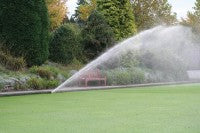Choosing the right irrigation system
 In the previous article we discussed the importance of certain system components being correctly specified, to avoid poor coverage and low efficiency (both mechanical and financial).
In the previous article we discussed the importance of certain system components being correctly specified, to avoid poor coverage and low efficiency (both mechanical and financial).
Following the article, I had the privilege of visiting numerous bowling clubs and sports pitches, all reporting similar issues, with the majority of initial conversations always seeming to contain the line "I don't think our sprinklers are working correctly".
In a few cases we inspected the systems and found that indeed the sprinkler units were suffering from worn nozzles, poor rotation speed or internal damage. Problems that were solved with minor replacement or repair works, constituting no more than routine maintenance.
However, the majority of inspections proved that my initial thoughts were correct, in that a huge number of systems are being installed to sub-standard designs, with very little knowledge of flows and pressures or friction losses and coefficient of uniformity.
On the whole, it is massively unusual for a sprinkler to be inefficient, this assuming that it is being operated with the correct volume of water at a suitable pressure, and is carrying out the task for which it was designed. It is very easy to forget that the majority of sprinkler manufacturers spend vast sums of money researching and developing each and every sprinkler model that they produce.
Sprinklers are tested, then tested some more at the factory, and then put out for field-testing in some of the harshest environments possible - environments that make our climate and irrigation requirements seem very average.
All of this design and testing is then brought to the market, usually assisted by a 3-5 year warranty. A warranty is only possible because the makers know they will not be replacing faulty units en masse and face financial ruin.
In short, by the time the sprinkler gets to all of us it will be reliable. It's a bad installer that makes it seem unreliable, with poor design skills and an urge to cut corners for financial gain.
Whilst I have the utmost respect for the majority of sprinkler manufacturers, this article was not written to "big them up". Ultimately, my stock answer to the question "which is the best sprinkler" is that "all are comparable pieces of black plastic, gauged by the manufacturer's confidence in his warranty offer".

Chances are that a 5-year warranty from a manufacturer (that's been around for more than 5-years) is a very good indicator of reliability and efficiency.
In general, a good contractor's choice of sprinkler will be governed by the same criteria as the clubs, in that a reliable unit means no costly warranty visits and good press all around.
Confidence in the product from the installer tends to go hand in hand with a good support chain from the manufacturer. You want to be sure that any product failure can be dealt with effectively and promptly, which tends to mean a manufacturer's presence within the country of installation.
So, ask your installer why they have specified a certain type of sprinkler and always insist on a unit with at least 3-years manufacturer's warranty. The installer should be able to demonstrate that his chosen sprinkler will cover the required area without shortfall, and identify to you the point on the sprinkler performance chart that lists the required flow and pressure to reach this coverage.
Then you can compare this information with the pump duty he has previously advised. The said pump duty should always exceed both flow and pressure requirements of the sprinkler, if not, it won't work! (The pump duty also needs to include pipe friction loss calculations and static rises, both of which will be discussed in the next article).
On sprinkler choice, I would always insist on 'valve in head' style units for bowls irrigation. This, put simply, means that the valve controlling the sprinkler is an integral part of the pop up unit, and not located remotely in the pump house or even buried below the unit. This type of sprinkler allows easy operation, both manually and automatically, and also allows maintenance to be carried out without full excavation, and usually incorporates a useful 'off' mode.
When choosing the type of sprinkler, consider the prevailing weather conditions during the watering season. For example, if you get strong or gusting winds across the green, it is worth considering some of the low trajectory units on sale.
Standard trajectory of a sprinkler arc is 25 degrees, which means that at its highest point the 'curtain' can be 3 or 4 metres above the greens surface, exposing it to wind disturbance. Low trajectory units tend to throw at below 15 degrees, keeping the curtain height down and reducing exposure to wind. If you do choose this type of unit be aware that the lower trajectory can affect the overall throw of the sprinkler. Your installer should allow this for.
So, remember, when choosing a system, the type or brand of the sprinkler unit is less important than the competence of the designer and installer. Good sprinklers installed correctly should always cover your green evenly and efficiently.
Next time we will discuss pipe, choosing your installer and how effective rain harvesting can be in a bowls environment.
